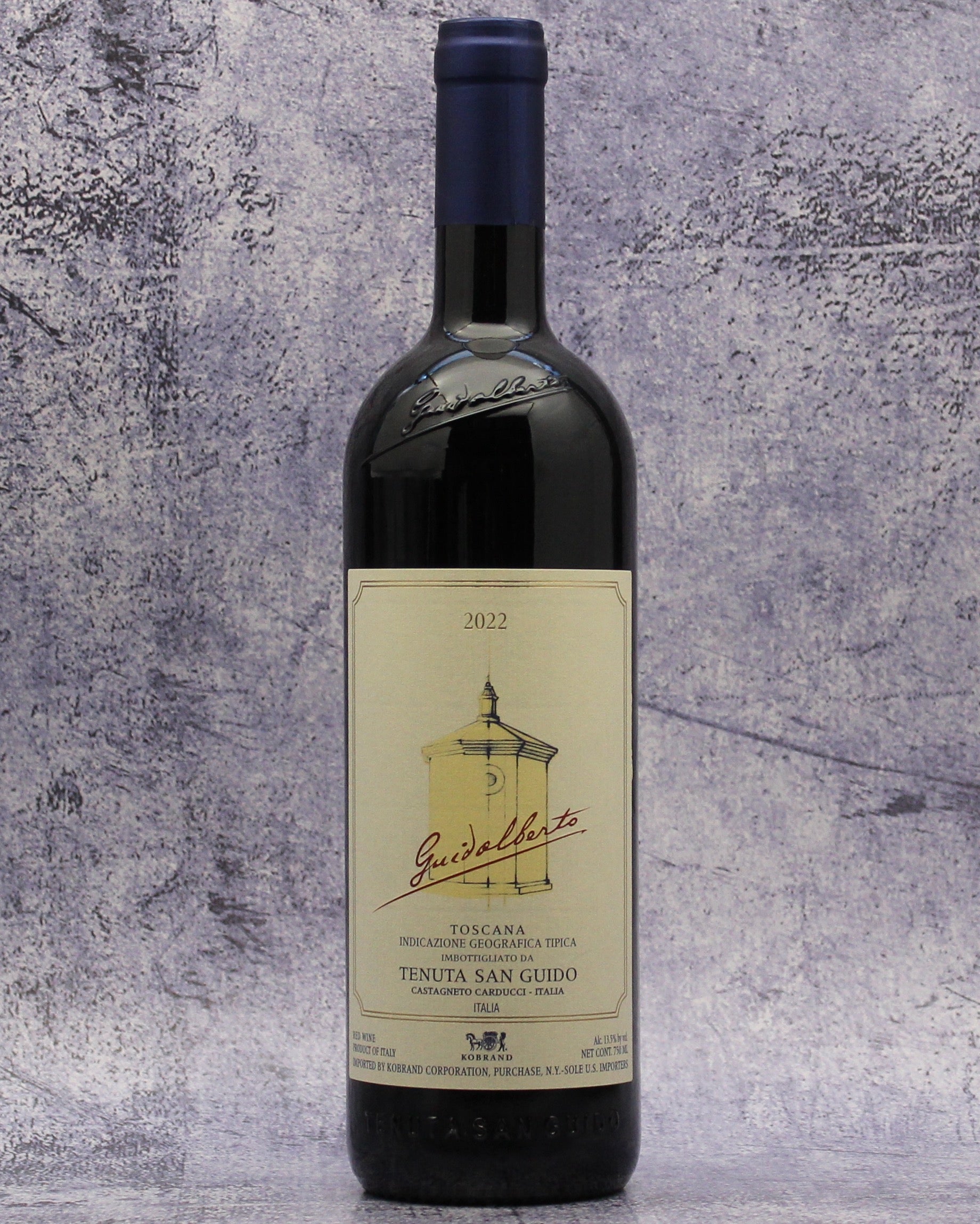Description
From: Tuscany, Italy
Varietals: 60% Merlot, 40% Cabernet Sauvignon
Tasting Notes and Critical Acclaim: “This vintage is a bit closed on the nose at a young age, it needs to breathe in the glass to reach its rich aromatic complexity. It recalls the Mediterranean scrub and its essences, strawberry tree, juniper but also earthy and humus notes. Its complex nuances identify its belonging to the terroir of origin. In the mouth the tannins are perfectly integrated, and their maturity accompanies the natural length of the wine on the palate, where freshness and depth stay in the foreground. Excellent salinity, not intrusive, which gives good length and persistence to the nose.” —Winemaker’s notes
"This red is elegant, despite its firm structure and dense tannins. Black cherry, black currant, plum, tobacco, iron and rosemary flavors hold court, while all the components show balance. The finish is long, with a salty taste.” —Bruce Sanderson, Wine Spectator 94 points (June 2024)
“Made with Merlot and Cabernet Sauvignon, the Tenuta San Guido 2022 Guidalberto gives you a good taste of the same DNA that brings us one of Italy’s greatest wines, Sassicaia, but it’s offered in a more immediate style here (thanks to the addition of the Merlot). This warm vintage opens to medium-dark concentration and very plump aromas that take you immediately to blackberry and blackcurrant sitting out in the sun at your local farmers market. The wine shows a soft and gentle side with a pretty level of elegance transmitted through the fruit freshness and the light oak spice that is discernible here but delivered with grace.” —Monica Larner, Wine Advocate, 94 points (March 2024)
“Lots of mint with sage and fresh rosemary to the currant and orange character on the nose, as well as some ripe raspberries. The palate is very refined with creamy and crunchy tannins that run the length of the wine. It shows a crunchy and energetic personality. Give it a year or two to come together, but it’s showing brightness for the vintage.” —James Suckling, 94 points (March 2024)
“Guidalberto used to be great value for money, and even though it's a bit pricier these days, the quality has also improved dramatically in recent vintages as Tenuta San Guido seeks to remove the idea of Guidalberto as a ‘second wine’ by building a dedicated winemaking facility and adjusting the blend. The 2022 is loaded with herbal and sea breeze scents among bright, tangy berries. In the mouth it is saline and precise, with a succulence to the concentrated plum and black berry core, and a gracefulness to the tannic and acid structures which weave through it. Sapid and incredibly moreish, with a beautifully ripe red berry finish, this really does stand up on its own two feet. (JB)” —Decanter, 93 points (May 2024)
Pairing: This impeccably balanced and polished Cab-Merlot blend will pair well with a range of rich, meat-based meals. To honor the wine’s Tuscan roots, you could pair it with the local Pappardelle al cinghiale, a pasta served with a fragrant wild boar sauce. However, other meat-based pastas like bolognese or spaghetti and meatballs would also work very well. Slow-roasted beef, wild game, grilled meats, or grilled portobello mushrooms with Mediterranean herbs will also do well with this wine. Today, we’re recommending a traditional Osso Buco (Italian Braised Veal Shanks) Recipe by Daniel Gritzer.
About Tenuta San Guido. The historic Tenuta San Guido estate is known for crafting Sassicaia, the world’s first Super Tuscan and an important contribution to Italy’s evolving reputation as a fine-wine producing nation in the mid-20th century. From the ambition of Marchese Mario Incisa della Rocchetta to plant Bordeaux varieties in Tuscany in the 1940s, to the arrival of acclaimed consulting enologist Giacomo Tachis, to the introduction of two additional wines to the brand, Tenuta San Guido has vaulted from success to success.
Mario Incisa acquired a number of Cabernet Sauvignon and Franc vine cuttings in 1944 and planted them on a sloping hillside of the San Guido estate, called Castiglioncello after the 11th-century castle at the vineyard's upper edge. The Marchese’s first vintages were not warmly received by critics, who were accustomed to the light, local wines made to be consumed by the March after harvest. Between 1948 and 1960, the vineyard’s tiny yield of barely 2 hectoliters per year was either consumed only by the family or left forgotten in the cellar.
In the early 1960s, a few of the Marchese’s well-versed colleagues tasted some of the older bottles. They expressed such enthusiastic praise that, in 1965, Mario Incisa resumed his project and planted a second Cabernet vineyard. Situated 650 feet lower than Castiglioncello, this gravelly parcel of 30 acres would give the wine its name: Sassicaia, meaning the place of many stones. The first vintage of Sassicaia offered on the open market was the 1968.
Mario Incisa’s insurgent use of the Cabernet variety in Tuscany, which relegated the wine to “vino da tavola” status according to DOC law, was compounded by his use of small oak barrels to mature the wine. The first harvest was matured in Slovenian oak casks of 225 liters, identical in size to the French barrique. In contrast to the large oak vats used to mature Chianti, the small barrique yielded a rapid, high extraction of oak. The result, predictably, was an initially hard, tannic wine.
During the late 1960s and early 1970s, important technical changes were made, and Nicolò Incisa began to take over wine production from his father and transform Tenuta San Guido into the internationally recognized producer of fine wines that it is today. In 1970, with his cousin Piero Antinori, Nicolò convinced his father to allow the commercialization of Sassicaia and formed an alliance with consultant Giacomo Tachis, who helped to modernize the production of Sassicaia, with controlled-temperature fermentation, lower yields and shorter maturation in oak. With the 1977 vintage, the first French Tronçais oak barriques were introduced, which made a dramatic difference in the wine.
The 2000 vintage was the first release of this wine—the Guidalberto Toscana Rosso IGT wine—from newly planted vineyards dedicated to its production. Named after Guidalberto della Gherardesca, a maternal ancestor of Nicolò Incisa who cultivated vines in Bolgheri in the 19th century, the wine is conceived differently from Sassicaia but shaped by the same soil and climate. The estate’s other wine, Le Difese, is an IGT Toscana companion wine to Guidalberto, sharing Sassicaia’s pedigree but highlighting different aspects of the winery.
The Tenuta San Guido estate now consists of 4,500 acres, of which 180 acres are planted in vines spread among 8 separate parcels. The cordon spur pruning method is employed and yields are kept to less than 2.5 tons per acre. The two main vineyards are Castiglioncello and Sassicaia, which were planted between 1965 and 1985 in successive phases along with the 20-acre parcel Aia Nuova. A more recent vineyard, called Quercione, was planted from cuttings from the Sassicaia parcel in 1989 and 1990 and is sited on a stony ridge high above the winery.
About this wine. The label depicts the Oratory of San Guido and the wine is named after the family ancestor Guidalberto della Gherardesca, an agricultural pioneer in the Bolgheri area. It was in the first decades of the 1800’s when he built the first factories, and churches, and planned the avenue of cypress trees, the Viale dei Cipressi. These trees were initially used to mark the boundaries between the different crops. Its ornamental value, with the tall cypresses running in double rows, came after that. Guidalberto is from the producers of the legendary Sassicaia, with a more approachable drinkability and a great aging potential. It is a great expression of the Tenuta San Guido territory.
The 2022 vintage is 60% Merlot and 40% Cabernet Sauvignon, grown on a complex terrain with a strong presence of limestone; certain vineyard areas are also rich in marl and pebbles as well as being partly clayey; they sit at an altitude of between 100 and 300 meters above sea level, with a south/south-west exposure.
The wine aged in partly in French oak and a small part (5%) in American oak for 15 months. 40% of the barrels were new, 40% were second passage, and 20% were third and fourth passage. This choice was made to best balance the release of tannins and, at the same time, keep the excellent primary and secondary aromas obtained from a great vintage in most of the musts in the foreground. Subsequent refinement of three months in glass before being released on the market.

